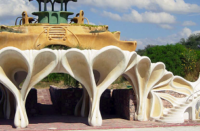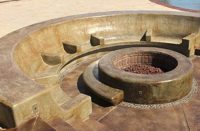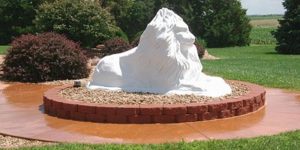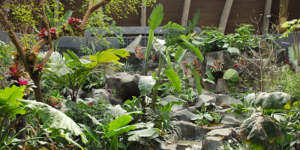- Many of the concrete tools you have right now will serve you well in constructing synthetic rocks. Use them creatively.
- Talk with your customers. Find out what they are thinking with regard to the project. Once you find out what they want, talk with them about the budget. You need to know both sides of the equation before you begin the design stage.
- Sorry, there is no one-size-fits-all concrete mix or construction technique. The mix and method you use will depend on your geographic location and the application.
- Positive rock work over re-bar and lath can remain hollow or be solid-filled. Some contractors recommend leaving the structure hollow in interior applications and filling it solid in exterior applications.
- Be sure to include architectural elements and plants in your rock feature for a more natural-looking result. Plant pockets are a common design feature.
- All work that will be submerged or is part of a water feature should be waterproof and/or grouted solid.
- Molds or texture mats taken right from Mother Nature offer the best reproduction.
- Texture mats or skins that are pliable are easier to use in many applications. The flexibility will allow you to wrap them around your rock shapes and curves without creasing.
- Texture can be imprinted, carved or sculpted, or created by adding material on.
- When working with veneers, there is a delicate balance to achieve with regard to curing without shrinking and cracking and not wetting the rock so much as to erase the texture.
- Coloring can be achieved by a variety of techniques, including dying or integral color, staining and painting. Some contractors use a combination of coloring methods, such as using a thick latex paint to create specks after staining.
- When applying color by hand, helpful tools can include sprayers, sponges, rags and whisk brooms (for splattering).
- Some synthetic rock contractors recommend sealing; others don’t, saying sealer makes it more difficult to repaint.
- Re-coloring and resealing intervals vary, depending on your geographic location, the materials used and the environmental/use factors.
- Synthetic rock features in freeze/thaw climates or in locations with unstable ground need to be constructed differently. Some possible solutions include: air entrainment, using an admix or building on footers. Determine what will work best for each project before you start.
- Synthetic rock features created from concrete can last indefinitely if cared for properly. Nonetheless, in the event something does happen, experienced contractors assert that most repairs are fairly simple.
- Water leaks, on the other hand, can be a nightmare. Be sure to include test time in your construction time frame.















